Related Research Articles

Motorenwerke Zschopau GmbH is a German motorcycle manufacturer located in Zschopau, Saxony. The acronym MZ since 1956 stands for Motorenwerke Zschopau GmbH. From 1992 to 1999 the company was called MuZ, an acronym for Motorrad und Zweiradwerk.

KTM is an Austrian motorcycle, bicycle and motorsports brand which is co-owned by Indian manufacturer Bajaj Auto and Austrian manufacturer Pierer Mobility AG. It traces its foundation in 1934 as Kronreif & Trunkenpolz Mattighofen. Today, Pierer Mobility AG operates as the manufacturer of KTM branded motorcycles; whereas KTM Fahrrad AG operates as the manufacturer of KTM branded bicycles.
The Honda XR series is a range of four-stroke off-road motorcycles that were designed in Japan but assembled all over the world.
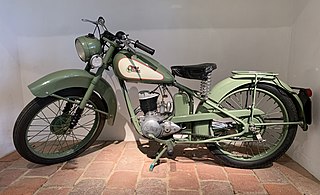
The BSA Bantam is a two-stroke unit construction motorcycle that was produced by the Birmingham Small Arms Company (BSA) from 1948 until 1971. Exact production figures are unknown, but it was between 350,000 and 500,000.

Syarikat Motosikal dan Enjin Nasional Sdn. Bhd, or known as Modenas for short is a Malaysian national motorcycle company producing various small motorcycle models below 400cc targeted for local market and export. The company's headquarters and factory are located at the small town of Gurun, Kedah, Malaysia.
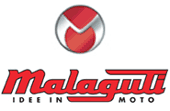
Malaguti is an Italian bicycle, scooter and motorcycle company based in San Lazzaro di Savena, founded by Antonino Malaguti in 1930. Producing bicycles until 1958, they then entered the motorcycle market. Noted for their use of small engines in their bikes. In October 2011, Malaguti laid off its remaining employees in Bologna, Italy as the company eventually folded.

In the market, there is a wide variety of types of motorcycles, each with unique characteristics and features. Models vary according to the specific needs of each user, such as standard, cruiser, touring, sports, off-road, dual-purpose, scooters, etc. Often, some types like sport touring are considered as an additional category or integrated with touring.

The Yamaha WR450F is an off-road motorcycle made by Yamaha Motor Company. It currently has a 450 cc (27 cu in) liquid-cooled single-cylinder engine. First offered in 1998 at 400cc, it shared many components and design concepts with the YZ400F motocross model. It is basically the racing YZ450F detuned slightly for more controllable power, with a headlight and lighting coil, softer suspension, a kickstand, lower noise specifications, larger radiators and lower emissions. The WR in the name indicates a wide-ratio gear box common to most enduro or trail bikes and stands in contrast to the close-ratio gearbox essential to a motocross racer. Over the years the WR has benefited from the advances made in the YZ motocross version gaining displacement and advancements such as an aluminum frame and improved suspension. Over much of its life the weight of the WR450F has remained fairly constant ranging from 244 to 249 pounds dry weight.

An enduro motorcycle is an off-road racing motorcycle used in enduros, which are long-distance cross-country, Trails, time trial competitions.

Beta is an Italian motorcycle manufacturer, specialising in off-road motorcycles. Beta is best known for their popular observed trials bikes. In 2005, they launched a range of enduro motorcycles using KTM engines. In 2010 they launched the new RR series, with a new engine made in-house. Beta motorcycles have been used by world trials champions such as Jordi Tarrés, Dougie Lampkin, Albert Cabestany and Enduro riders Steve Holcombe and Brad Freeman. Production in 2018 was expected to be in excess of 20,000 motorcycles, ranging in size from 50 cc to 480 cc.

The Yamaha XT125R is a four-stroke, single cylinder enduro/adventure motorcycle. It was made by Yamaha since the 2003 model year. It shares its power plant with the YBR125 and its supermoto brother, the Yamaha XT125X. While parts such as the transmission and chassis are produced in Japan, and the engine in Brazil, the motorcycle itself is assembled in Bologna, Italy for the European market by the Italian bike company Malaguti.
Motorcycle components and systems for a motorcycle are engineered, manufactured, and assembled in order to produce motorcycle models with the desired performance, aesthetics, and cost. The key components of modern motorcycles are presented below.
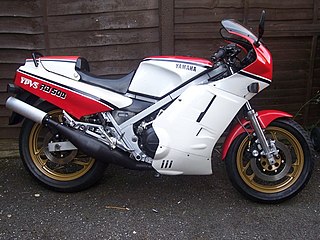
The Yamaha RD500LC is a high-performance, two-stroke sports motorcycle, also known as the RZ500 in Canada and Australia. A lightened but detuned version known as the RZV500R was developed for the Japanese home market. Strict United States Environmental Protection Agency regulations meant that the RZ500 was not available for sale in that country. Produced for a short period between 1984 and 1986 it has become a sought after collector's machine.

The BMW F650 is a family of motorcycles developed by BMW Motorrad beginning in 1993. Models included the F650St Strada and from 1994, the F650 which, due to some subtle differences, was considered to be a more dual/multi purpose motorcycle with some off-road capability. The 1993 - 2000 F650 was the first single-cylinder motorcycle from BMW since the 1960–1966 R27, and the first chain driven motorcycles from BMW.

The Yamaha Enticer is an entry-level cruiser motorcycle that was produced from 2002 to 2006 in India. It is no longer in production. It featured a feet-forward cruiser-type riding position and was available in two trim levels, the regular and the delux. The delux variant had a self-starter and disk brakes for the front wheel.

The Yamaha XT660Z Ténéré is a dual-sport motorcycle manufactured from 2008 to 2016 by Yamaha. It featured a 660 cc (40 cu in) single-cylinder engine manufactured by Minarelli, which was also used in the XT660R, XT660X, MT-03 ( 2006–2014), Jawa 660 Sportard, Jawa 660 Vintage and Aprilia Pegaso 650 Trail models. Though not sold in the US or Canada and some 40 kilos heavier than the original, air-cooled Ténéré from the early 1980s, many fans saw the 660Z as a return to form for Yamaha, following the demise of the air-cooled Teneres and the less popular 5-valve iteration which replaced them. The low-rpm electronic fuel injection glitches present in previously listed machines using the same, 660 engine were ironed out and the 660Z could reliably average 4 L/100km ""user averages closer to 55MPG imperial"". which equated to 600 km or nearly 400 miles on a single tank. Other notable qualities included its strong rear subframe, 23-litre tank and effective fairing.

Kawasaki motorcycles are manufactured by the Motorcycle & Engine division of Kawasaki Heavy Industries.

The Kawasaki A1 Samurai is a 250 cc (15 cu in) standard class Kawasaki motorcycle which was sold from 1967 through 1971.
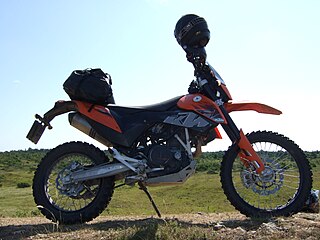
The KTM 690 Enduro is a dual-sport motorcycle made by KTM from 2008 to the present day. The 690 Enduro R, introduced in 2009, was initially marketed as a more offroad-oriented version of the adventure-touring-oriented Enduro. The 690 Enduro nomenclature was dropped in 2011; the 690 Enduro R remains in serial production as of January 2024.
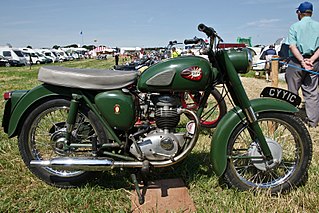
The BSA B40 was a series of 350 cc (21 cu in) unit construction single-cylinder OHV four-stroke motorcycles made by the Birmingham Small Arms Company. Developed from the BSA C15, the machines were produced between 1961 and 1967 for civilian use. Military versions were manufactured from 1967 to 1970. Around 14,000 machines were built in total.
References
- 1 2 3 4 5 6 7 8 9 10 11 12 13 14 15 16 17 18 19 20 21 22 23 24 25 "69-71 AT1 125 Specifications". Yamaha Enduros. Retrieved 2024-08-30.
- ↑ "Yamaha AT1C 125 Enduro Battery Replacement (1969-1971)". Tech Battery Solutions. Retrieved 2024-08-30.
- ↑ "1969 - 1971 AT1 & CT1 Fuel Tanks Same Size?". Vintage Enduro Discussions. 2021-09-17. Retrieved 2024-08-30.
- ↑ "Brand New Yamaha Petcocks for our bikes!". Yamaha Enduros. 2014-06-06. Retrieved 2024-08-30.